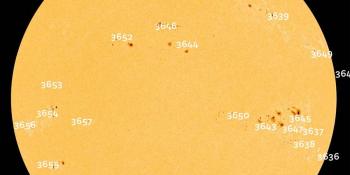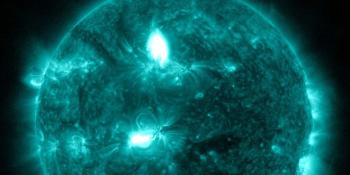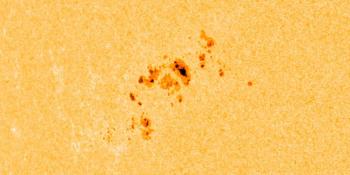Viewing archive of czwartek, 8 marca 2012
Raport aktywności słonecznej
Any mentioned solar flare in this report has a scaling factor applied by the Space Weather Prediction Center (SWPC). Because of the SWPC scaling factor, solar flares are reported as 42% smaller than for the science quality data. The scaling factor has been removed from our archived solar flare data to reflect the true physical units.
Raport aktywności słoneczno- geomagnetycznej 2012 Mar 08 2200 UTCPrzygotowane przez NOAA © SWPC i przetworzone przez SpaceWeatherLive.com
Połączenie raportów USAF/NOAA o słonecznej i geofizycznej aktywności
Numer SDF 068 wydany w 2200Z na 08 Mar 2012IA. Analiza aktywności regionów słonecznych i aktywność od 07-2100Z do 08-2100Z Solar activity was low. A C7/Sf flare was observed
from Region 1428 (S17W19). Region 1429 (N17E01) remains a large Ekc
spot group with a Beta-Gamma-Delta magnetic classification.
Possible separation was observed within the intermediate area of the
spot group.
IB. Prognoza aktywności słonecznej
Solar activity is expected to continue
at low to moderate levels with a chance for further X-class activity
from Region 1429 for the next three days (09 - 11 March).
IIA. Podsumowanie aktywności geofizycznej 07-2100Z do 08-2100Z
The geomagnetic field ranged from quiet to minor storm conditions
with major storm periods observed at high latitudes during 08/1200 -
1800Z. At 08/1045Z, a 40 nT shock was observed at the ACE
spacecraft from the arrival of the coronal mass ejection (CME)
associated with the X5 flare that occurred early on 07 March. A
sudden impulse was observed shortly after at the Boulder
magnetometer at 08/1105Z (59 nT). Minor storm periods were observed
as a result of the CME arrival. The greater than 10 MeV proton
event that began at 07/0510Z increased to a maximum of 6530 pfu at
08/1115Z as a result of the CME shock. The greater than 100 MeV
proton event that began at 07/0405Z, and reached a maximum value of
69.3 pfu at 07/1525Z, has slowly declined.
IIB. Prognoza aktywności geofizycznej
The geomagnetic field is
expected to be unsettled to active with isolated minor to major
storm periods possible on day 1 (09 March) as the Earth continues to
be under the influence of the CME from 07 March. Quiet to unsettled
conditions with isolated active periods possible are expected for
days 2 - 3 (10 - 11 March).
III. Prawdopodobieństwa zdarzenia 09 Mar do 11 Mar
| Klasa M | 80% | 80% | 80% |
| Klasa X | 40% | 40% | 40% |
| Proton | 99% | 99% | 70% |
| PCAF | red | ||
IV. Przepływ 10,7 cm z Penticton
Zaobserwowano 08 Mar 140 Przewidywane 09 Mar-11 Mar 140/135/135 Średnia z 90 dni 08 Mar 125
V. Indeks geomagnetyczny A
Zaobserwowano Afr/Ap 07 Mar 033/064 Szacowane Afr/Ap 08 Mar 018/027 Przewidywane Afr/Ap 09 Mar-11 Mar 017/027-007/012-007/010
VI. Prawdopodobieństwa aktywności geomagnetycznej 09 Mar do 11 Mar
| A. Średnie szerokości geograficzne | |||
|---|---|---|---|
| Aktywne | 35% | 15% | 15% |
| Słaba burza | 25% | 05% | 05% |
| Bardzo znacząca burza | 10% | 01% | 01% |
| B. Wysokie szerokości geograficzne | |||
|---|---|---|---|
| Aktywne | 15% | 25% | 25% |
| Słaba burza | 20% | 15% | 15% |
| Bardzo znacząca burza | 20% | 10% | 10% |
<< Idź do codziennego przeglądu
Najnowsze wiadomości
Najnowsze wiadomości z forum
AR 3637, 3638, 3643 86Unproven theories 341Space Weather Memes 338Filaments and prominences 55Growth of Cycle 25 433
Więcej tematówWesprzyj SpaceWeatherLive.com!
Wielu ludzi odwiedza SpaceWeatherLive aby śledzić aktywność słoneczną lub sprawdzić czy jest szansa na zaobserwowanie zorzy polarnej. Niestety, większy ruch na stronie oznacza większe koszty utrzymania serwera. Dlatego, jeśli jesteś zadowolony ze strony SpaceWeatherLive, zachęcamy do wspierania nas finansowo. Dzięki temu będziemy mogli utrzymać naszą stronę.

Fakty na temat pogody kosmicznej
| Ostatnie rozbłyski klasy X | 2024/03/28 | X1.1 |
| Ostatnie rozbłyski klasy M | 2024/04/24 | M2.0 |
| Ostatnia burza geomagnetyczna | 2024/04/19 | Kp7 (G3) |
| Spotless days | |
|---|---|
| Ostatni dzień bez skazy | 2022/06/08 |
| Monthly mean Sunspot Number | |
|---|---|
| marca 2024 | 104.9 -19.8 |
| Last 30 days | 128.8 +21.5 |


